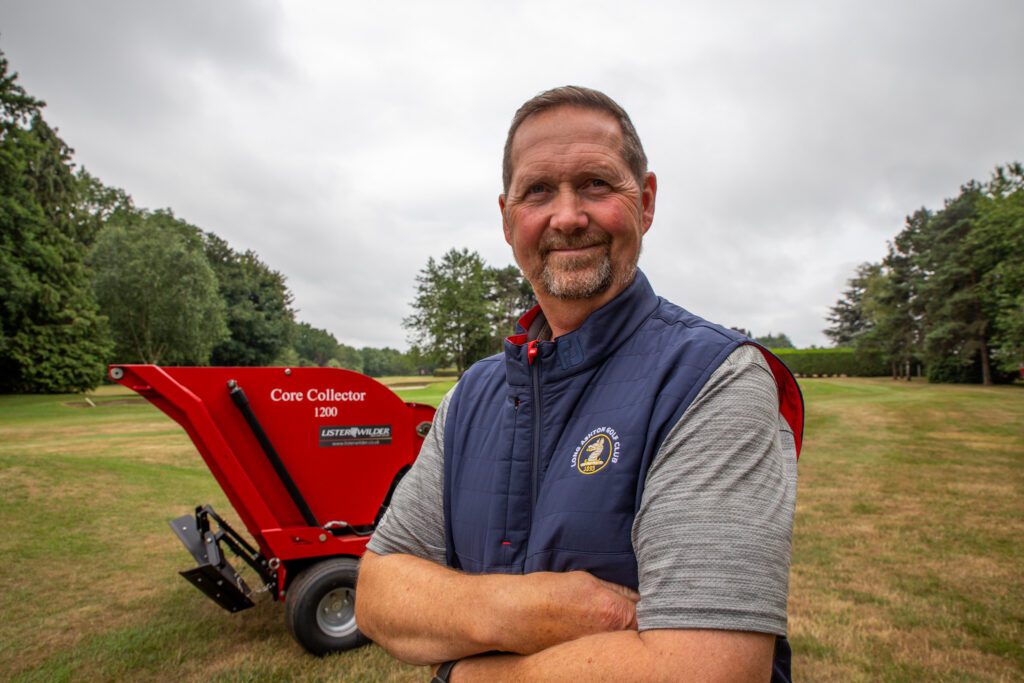
Getting to the roots of a compaction challenge
Golf’s ever growing popularity brings with it a host of benefits, but it also poses challenges that an experienced Course Manager like James Braithwaite takes seriously. In particular, more golfers playing increasingly regularly – and often over 12 full months of the year – can create significant greens compaction.
If drainage becomes less efficient, grass roots will be prevented from absorbing oxygen and the overall quality of the greens will be diminished. While hollow tining allows the compacted turf to expand and air and moisture to be more easily absorbed, it needs to be planned with care in order to minimise disruption to loyal golfers.
It is with that in mind that James added a Redexim Core Collector to his extensive shed of equipment at Long Ashton Golf Club on the edge of Bristol – and he is glad he did. “I initially hired one one from Lister Wilder for a week, and that allowed us to do not just the greens but the tees as well to very good effect,” says James. “We decided it was useful to have one readily available for a wider programme so we bought one in the early part of this year.”
James reckons that in the course of a typical day, and with two of his team engaged, they can get 12 to 14 greens cored and cleaned of the debris. A pedestrian operated machine, it collects cores and debris into a hopper that empties hydraulically, potentially saving many man hours.
“We find that’s it’s a perfect size – not too big and not too heavy,” says James. “The idea of getting this model was that the ground pressure is not too great so it doesn’t cave in the holes created by tining. We dress across it and make good with a sweep and fill brush. The core collector is robust, easy to use, works well in the wet and is reasonably priced.”
James is working towards a programme that involves hollow coring in October and then regular scarifying and lighter micro tining from March through the summer to keep compaction at bay.
Lister Wilder’s hire option means that courses can if they prefer take advantage of a special renovation rate, with the machine typically delivered either on a Friday or Saturday prior to the hire, ensuring that it is ready to start work early on a Monday morning.
In the hands of James and his five-man crew at Long Ashton, the core collector is making a useful contribution to a course with a big reputation. Projects they have handled in-house over recent years include a bunker regeneration programme that involved re-shaping, installing artificial faces and putting down a rubber crumb liner.
The course at Long Ashton started its life in 1893 with nine holes. Twelve years later, acquisition of further land provided the stepping stone to add a second nine holes. Set in 220 acres of mature wooded parkland and situated just ten minutes from Bristol’s city centre, Long Ashton is today one of the area’s premier golf clubs. It has 800 members and a forward looking approach to adding features like a 16-acre driving range equipped with Trackman to radar track the ball in real time – an invaluable aid to better driving.
But no amount of technology will replace the human skills that make the course what it is. “I have a fantastic team and they have really smashed it this year because the course is looking and playing superb,” says James. He is, however, the sort of course manager who attracts loyalty. He typically starts his working day at 4.15am and then, after clearing paperwork, heads over to the clubhouse to fetch each of his greenkeepers a coffee for their 6am arrival. He also provided the thermos style mugs that ensure that those drinks stay warm for longer!